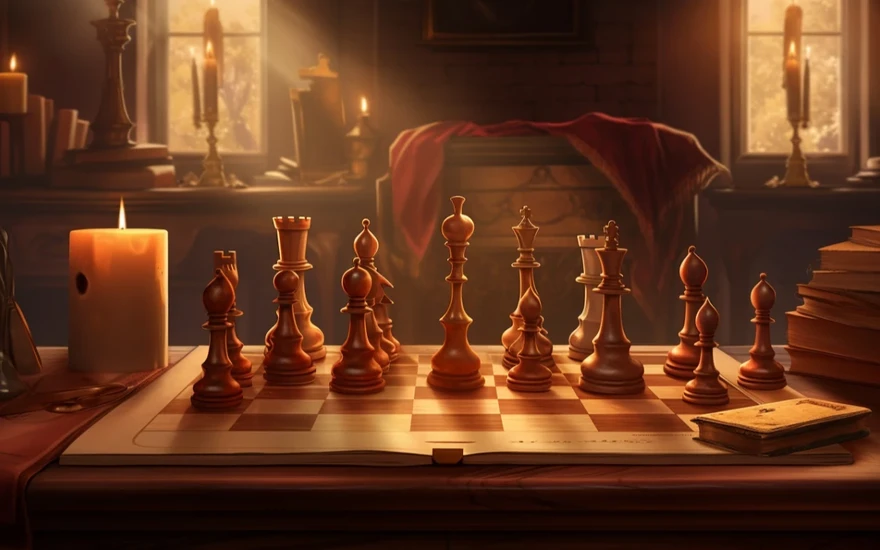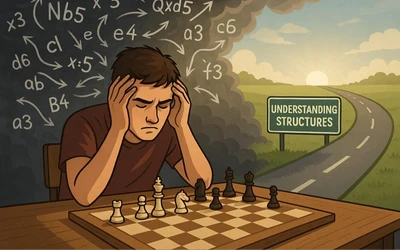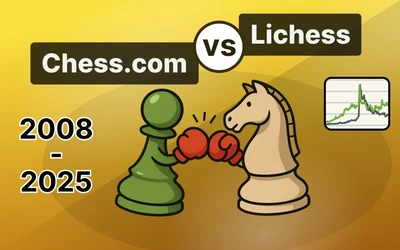
AI Generaed
The Complete Guide to Chess Opening Principles -"King Safety Driven Development"
Hi all
As part of the research I made on chess opening principles in the recent month, I feel I have something quite interesting and unexpected to share. And that is a mind shift from the classic opening principle advice of:
Practical priorities:
- Develop pieces
- Fight for the center
- Castle early
This advice seems absolutely sensible and practical and reflects the chess move order of things. But it lacks "strategic intent".
I believe instead, the conceptual priorities in the following order and replacing "Castle early" with King safety is much more effective:
- King Safety (think of as top priority)
- Central Square control (think of as a second priority)
- Develop pieces efficiently and with purpose - especially purpose 1 and purpose 2 above!
I am convinced my openings are much better with this order of priority in mind when playing opening moves. So what is the difference here? Well, actually it is pretty massive. This seems to be one of those secrets just hiding in plain daylight. The issue with saying to people to develop pieces, and control the center, and then castle, is that it can lead to irreparable damage to one's position if the agenda of King safety and central square control were not clearly in mind when developing pieces. To make sure you put those two agendas in mind, you need to think about them as the top two priorities.
Yes, this essentially goes against thousands of articles on "Chess Opening Principles". But there are analogies in other domains. In programming, there is the concept of "test-driven development". You write a code test first, and then do the code to initially fail that test. Then you try and make the code pass the test. This reversal of priorities means the code is testable, and test coverage is potentially 100%. If we do the same in chess, basically the tests are "King safety" and "Central square control" in that order. Before daring to do any developing move, make sure the developing move passes that criteria first. You can call this perhaps "King-Safety first, then Central square control-driven development" or just "King safety Driven Development".
It is also something in Information systems that is interesting to think about:
When is a business resource "Strategic" and when is it just "Factory"?
It is when the strategic intent of that resource use is strategic. So it could be a humble pen. As the saying goes:
"The pen is mightier than the sword".
Even humble resources, when imbued with strategic intent, can become much more important. A pen can be used to sign an important business contract. Or it may save someone's life as it is used for a critical letter. The resource itself may be humble. But the strategic intent may not be. The pen can become mightier than the sword. When we develop pieces in any opening, it is good to set the strategic intent.
So basically yes, i am saying most people on this site (including me) often play sloppy opening moves because they feel they are "developing pieces" and castle and job done. And yes, this blog tries to address that by making sure your strategic intent behind developing moves is set out beforehand.
Why "King Safety" instead of the usual Early Castling recommendation?
First of all, casting does not guarantee King safety. So this is a more powerful concept, which gets to the reason why casting is recommended generally- and early casting in particular. The idea behind casting is to ensure King safety. If you agree with this, that is good, because the next bit is going to take a bit more convincing.
Example game #1 recently with this updated mindset - Tango from a King safety enhanced perspective :
Castling Queenside with the King safety first mindset seemed safer than my routine usually disaster against this player when I castle K-side and get slaughtered. The beauty of King safety as a priority is that it also conveniently carries over into the middlegame to strengthen focus there without interruption.
A routine slaughter example I suffered when routinely casting K-side
Which is safer here - casting queenside - and making sure development geared up for that - or casting Kingside? I feel it is casting Queenside right now :)
Example #2 - Elephant gambit from a King safety perspective
The Elephant gambit can be pretty dangerous at fast time controls because of K-safety issues if the defensive Knight on f3 is not there. As an example, against a great rival, I have had better results with Elephant gambit than my usual slaughter in the French defence
The usual slaughter in French defence - which often relates to King safety issues
So which opening is better - well from a King safety perspective against that particular opponent of mine? The Elephant Gambit has been the clear winning in result terms against this particular formidable opponent!
In terms of online speed chess as well, if you are not checkmated you are still in the game. If you don't have to worry too much about your King you can maybe speed up your moves without a KIng fatality. So it makes sense as well for speed chess that King Safety is really helpful.
Example of not casting and having better King safety than the opponent - FM Peter Sowray vs GM Ian Rogers
A classical OTB game shows that the act of casting really should have the question: "Is it really safe". The Australian GM Ian Rogers plays Kd7 - and shows that White's King safety is worse than Black's. All of black's "developing moves", and also the "Undeveloping moves" too can be seen from a King safety perspective.
Rewind this game earlier as well:
Nc6-b8 - a shocking undeveloping move!. But the King is safe here if we think about it. The center is closed, so the King in the center isn't that easy to exploit in this particular position. What is White's most dangerous attacking piece? It is often the bishop on d3. What is black's worst piece - the c bishop. Why not Nc6-b8 undeveloping - but aiming to not just improve black's King safety if Ba6 supported as well as c5 enabled to try and swap off that bishop - but also if there is a bishop on a6 then it controls the White King escape square f1. So the whole preparation for Ba6 actually has a perspective of relative King safety if you think about it. If King safety is the driver, then we can even entertain "undeveloping moves" as this game shows.
Why think about King safety first as the major opening principle?
Checkmate ends the game. For me this is one of the most iron-clad principles going. If you don't have King safety in mind, then all sorts of opening disasters can happen. You can routinely develop and castle, and you have just castled into an attack. There might be an essential move before completing development that is important to increase your King safety more. Without such a move, there might be a strong tactical blow. Here is such an example:
b6 is routinely played, which is a developing move trying to sort out the c8 bishop. This leads to basically irreparable damage. The King safety agenda needs to be the top priority in the opening, and is especially going to be tested when playing black if it is not. You can see that Capablanca inflicted a d5 break, and was soon exposing the opponent's king.
Why Central Square control is the second major chess opening priority principle
The notion of "fight for the center" is a bit vague. Central square control is more specific. The following four squares of the chessboard: e4,d4,e5,d5
They are like the hill of a battlefield. Strategically important.
Classical vs Hypermodern approach to central square control - pros and cons
Note that something interesting about this to bear in mind:
If black plays e5, it is not just about central square control, black is also stopping white's pawn from e4-e5.
The classic "central square occupation" with a pawn does have the benefit of blockading the opponent's central pawns if they are there.
If we want to fight in a hypermodern way, we incur risk:
There is the possibility of d5 or e4 from White later, which usually needs to be restrained by black.
The advantage of the Hypermodern approach is that pieces can not just control central squares but can point through those to the King, e.g.
The bishop is x-raying g2. A perk of hypermodern central control is that the pieces can be active through the central squares.
So the point here is that central square control in the classical approach to the center often has a positive physical blockade of the opponent's center pawns. The Hypermodern approach, leaving out literal occupation of the center by pawns means pieces can be dangerously x-raying through the center. Pawns tend ot get in the way of pieces.
The other classic upside of hypermodern openings is the invitation for opponents to occupy the center and for that central occupation itself to become a target later.
Why Developing Pieces is the 3rd order of thinking
With the King safety agenda set in mind, as well as central control, the pen becomes mightier than the sword!. Your developing moves stop just being factory-produced developing moves. They become strategically important.
So :
CORE PRINCIPLE: Complete Development Fast & with purpose (e.g., K safety/ center)
Now there are the usual supporting principles for piece development, like:
DEVELOPMENT SUPPORT: Don't move the same piece twice (unless necessary)
DEVELOPMENT SUPPORT: Connect your rooks – complete your development
DEVELOPMENT & KING SAFETY SUPPORT: Don’t Be Too Greedy Early On
DEVELOPMENT SUPPORT: Don’t Bring Your Queen Out Too Early
DEVELOPMENT SUPPORT: Don’t leave pieces unprotected or potentially unprotected
Sure these are all good ideas to bear in mind as part of that 3rd priority of opening thinking.
The Advantage of just 3 CORE Opening Principles
With just 3 major core opening principles to use and in the priority order of King safety first, it is more manageable than thinking of various lists which seem to go on and on, like "Try not to move the same piece twice". That really goes under the third priority of developing pieces efficiently and with purpose. In working memory, there is the traditional 5 plus or minus 2, which we can hold in our brain for lists. Having just 3 major "CORE" principles is important for our brains not to overload.
There are a lot of articles about chess principles which have more than 3- sometimes this can really drown out the key priorities - a situation made worse when King Safety is the top priority and thinking about things like "Don't have doubled pawns" is not going to be helpful as an opening principle, or "Don't have unprotected pieces". I personally like the 3 major core ones in the order of this blog recommendation. Others can be part of general opening guidance, and there are also practical aspects of openings, like:
PRACTICAL: Know the standard pawn structure plans
PRACTICAL: Choose simple and solid openings to focus more on core skills
PRACTICAL: Choose openings that suit your style - better accuracy later likely
PRACTICAL: Avoid memorising without understanding
PRACTICAL: Don’t blindly trust theory or published analysis
PRACTICAL: Be cautious of playing for "bad" traps
PRACTICAL: Carry King Safety into the Middlegame as a priority
PRACTICAL: Carry Central square control into the Middlegame as a priority
These practical aspects can also help navigate the vast amount of opening theory generally - how to choose from it solid and simple stuff, which fits one's playing style, can be a particularly great idea. The potential for accuracy later is greater if you feel right at home in those types of positions. But the 3 CORE principles remain. Knowing pawn structure plans can simplify learning openings, as many openings share the same basic pawn structure.
That is not to say these practical ideas are also underestimated by many who are too intent on memorising tonnes of opening theory without question. The probability also of memorised lines turning up can be quite small as well. So there is a case for fully understanding the impact of these practical ideas. One example could the popularity of the London system in recent years which is not very theoretical but does have good King safety generally and is also pretty simple and solid.
Joyfully Elevating one's opening play baseline generally for any opening you play
The interesting thing to bear in mind about these as well as the other two core principles, is that we can have joyful master games to elevate one's opening play BASE LINE. So no need to laboriously memorise variations that will never turn up - just enjoy particular masterpieces, and feel your opening baseline rise up for anything you play.
Classic "Joyful" examples that can improve our opening play "baseline"
Rubinstein's Immortal game reminds us of the importance of not losing tempo in the opening. Black's play in a symmetrical looking position means black is actually ahead in development and first to strike on the front of King safety with Ne5:
And a devastating combination follows.
Bobby Fischer's "Game of the Century" reminds us about not moving the same piece twice
Moving the bishop again to g5 triggered a magnificent combination from Fischer:
Nimzovich's classic reminds us of not being too greedy in the opening when the King remains in center :
Black's greedy queen moves early on really punished well by Nimzovich here:
And there are many more iconic games which show opening disasters and highlight particular priorities of opening to play to care about.
Conclusions and Philosophical Points
When you see the opening principle advice of :
"Develop pieces, control the center, and castle early."
BEWARE! This can be a recipe for complete irreversible damage to your position!. It is like the rush to code without TDD. It is like Indiana Jones not doing his research first before raiding an Ark! Think about how he avoids instant death by becoming familiar with the traps and pitfalls first. It is like a pen not becoming mightier than a sword, because you did not imbue that pen with the strategic priorities! You just developed for the sake of developing. You just castled for the sake of just casting.
The real scalable advice against stronger and stronger opposition, which isn't a fairy tale easy recipe,e is the following:
1. Think about King Safety as the top priority
2. Think about central square control as the next priority.
3. Develop your pieces efficiently AND purposefully for 1. and 2 above.
If you want to get hold of my in depth course "The Complete Guide to chess principles", please use my course page which has discount links:
https://www.chessworld.net/chessclubs/learn_coaching_chessable.asp#openingprinciples
Trailer video for my detailed course on this subject:
https://www.youtube.com/watch?v=ZvR9HleS0FA
Enjoyed this post? Your likes and follows are immensely appreciated!
And feedback welcome from all
Cheers, K
Explore My Chess Courses
Want to go further? Explore all my online chess courses at https://www.chessworld.net/online-chess-courses.asp – learn openings, tactics, strategy, and more.
Enjoyed this post? Your likes and follows are immensely appreciated!
Cheers, K
Discuss this blog post in the forum
You may also like
 FM MathiCasa
FM MathiCasaChess Football: A Fun and Creative Variant
Where chess pieces become "players" and the traditional chessboard turns into a soccer field CM Kingscrusher-YouTube
CM Kingscrusher-YouTubeSupercharge Your Chess Tactics by Punishing Mistakes
Mistakes are what makes chess fun especially at lower levels. We need to be really good at punishing… CM Kingscrusher-YouTube
CM Kingscrusher-YouTubeAn appreciation of Mir Sultan Khan - FIDE Honorary Chess Grandmaster
Called a Genius by Capablanca. An intriguing player in Chess history who was able to win tournaments… FM benkonian
FM benkonian“Are you studying openings wrong? A Coach’s Honest Take”
Openings are probably the most discussed topic in the chess community, especially at the club level.… CM Kingscrusher-YouTube
CM Kingscrusher-YouTubeThe importance of Chess Visualisation skills
Reminders abound for the importance of chess visualisation skills ChessMonitor_Stats
ChessMonitor_Stats